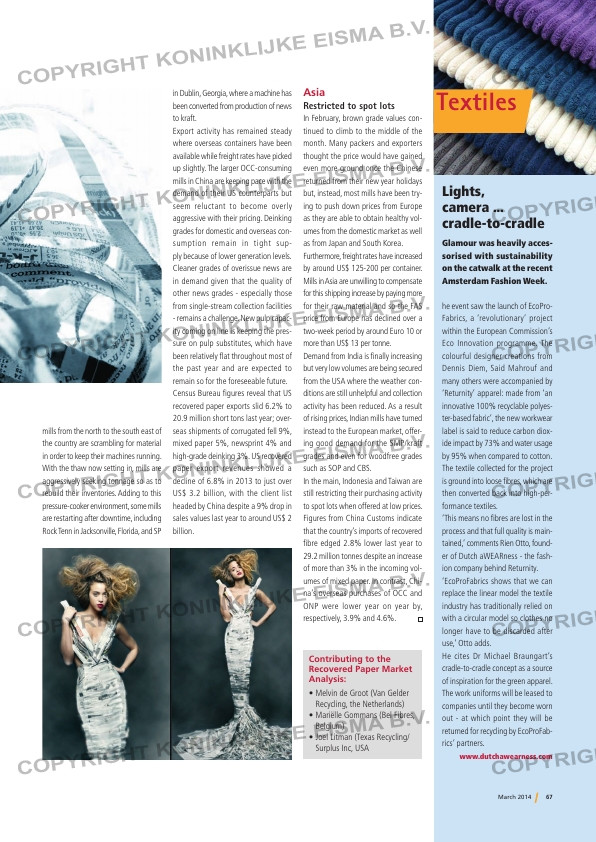Page 67 from: March 2014

Textiles
67March 2014
mills from the north to the south east of
the country are scrambling for material
in order to keep their machines running.
With the thaw now setting in, mills are
aggressively seeking tonnage so as to
rebuild their inventories. Adding to this
pressure-cooker environment, some mills
are restarting after downtime, including
Rock Tenn in Jacksonville, Florida, and SP
in Dublin, Georgia, where a machine has
been converted from production of news
to kraft.
Export activity has remained steady
where overseas containers have been
available while freight rates have picked
up slightly. The larger OCC-consuming
mills in China are keeping pace with the
demand of their US counterparts but
seem reluctant to become overly
aggressive with their pricing. Deinking
grades for domestic and overseas con-
sumption remain in tight sup-
ply because of lower generation levels.
Cleaner grades of overissue news are
in demand given that the quality of
other news grades – especially those
from single-stream collection facilities
– remains a challenge. New pulp capac-
ity coming on line is keeping the pres-
sure on pulp substitutes, which have
been relatively fl at throughout most of
the past year and are expected to
remain so for the foreseeable future.
Census Bureau fi gures reveal that US
recovered paper exports slid 6.2% to
20.9 million short tons last year; over-
seas shipments of corrugated fell 9%,
mixed paper 5%, newsprint 4% and
high-grade deinking 3%. US recovered
paper export revenues showed a
decline of 6.8% in 2013 to just over
US$ 3.2 billion, with the client list
headed by China despite a 9% drop in
sales values last year to around US$ 2
billion.
Asia
Restricted to spot lots
In February, brown grade values con-
tinued to climb to the middle of the
month. Many packers and exporters
thought the price would have gained
even more ground once the Chinese
returned from their new year holidays
but, instead, most mills have been try-
ing to push down prices from Europe
as they are able to obtain healthy vol-
umes from the domestic market as well
as from Japan and South Korea.
Furthermore, freight rates have increased
by around US$ 125-200 per container.
Mills in Asia are unwilling to compensate
for this shipping increase by paying more
for their raw material and so the FAS
price from Europe has declined over a
two-week period by around Euro 10 or
more than US$ 13 per tonne.
Demand from India is fi nally increasing
but very low volumes are being secured
from the USA where the weather con-
ditions are still unhelpful and collection
activity has been reduced. As a result
of rising prices, Indian mills have turned
instead to the European market, offer-
ing good demand for the SMP/kraft
grades and even for woodfree grades
such as SOP and CBS.
In the main, Indonesia and Taiwan are
still restricting their purchasing activity
to spot lots when offered at low prices.
Figures from China Customs indicate
that the country’s imports of recovered
fi bre edged 2.8% lower last year to
29.2 million tonnes despite an increase
of more than 3% in the incoming vol-
umes of mixed paper. In contrast, Chi-
na’s overseas purchases of OCC and
ONP were lower year on year by,
respectively, 3.9% and 4.6%.
Contributing to the
Recovered Paper Market
Analysis:
• Melvin de Groot (Van Gelder
Recycling, the Netherlands)
• Mariëlle Gommans (Bel Fibres,
Belgium)
• Joel Litman (Texas Recycling/
Surplus Inc, USA
Lights,
camera …
cradle-to-cradle
Glamour was heavily acces-
sorised with sustainability
on the catwalk at the recent
Amsterdam Fashion Week.
he event saw the launch of EcoPro-
Fabrics, a ‘revolutionary’ project
within the European Commission’s
Eco Innovation programme. The
colourful designer creations from
Dennis Diem, Said Mahrouf and
many others were accompanied by
‘Returnity’ apparel: made from ‘an
innovative 100% recyclable polyes-
ter-based fabric’, the new workwear
label is said to reduce carbon diox-
ide impact by 73% and water usage
by 95% when compared to cotton.
The textile collected for the project
is ground into loose fi bres, which are
then converted back into high-per-
formance textiles.
‘This means no fi bres are lost in the
process and that full quality is main-
tained,’ comments Rien Otto, found-
er of Dutch aWEARness – the fash-
ion company behind Returnity.
‘EcoProFabrics shows that we can
replace the linear model the textile
industry has traditionally relied on
with a circular model so clothes no
longer have to be discarded after
use,’ Otto adds.
He cites Dr Michael Braungart’s
cradle-to-cradle concept as a source
of inspiration for the green apparel.
The work uniforms will be leased to
companies until they become worn
out – at which point they will be
returned for recycling by EcoProFab-
rics’ partners.
www.dutchawearness.com
RI-2-2014-MA Paper&Textiles.indd 67 06-03-14 09:22



